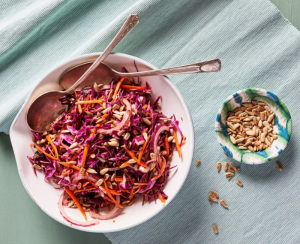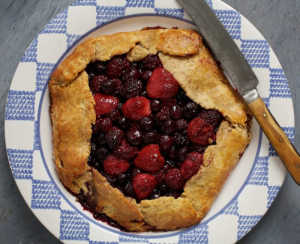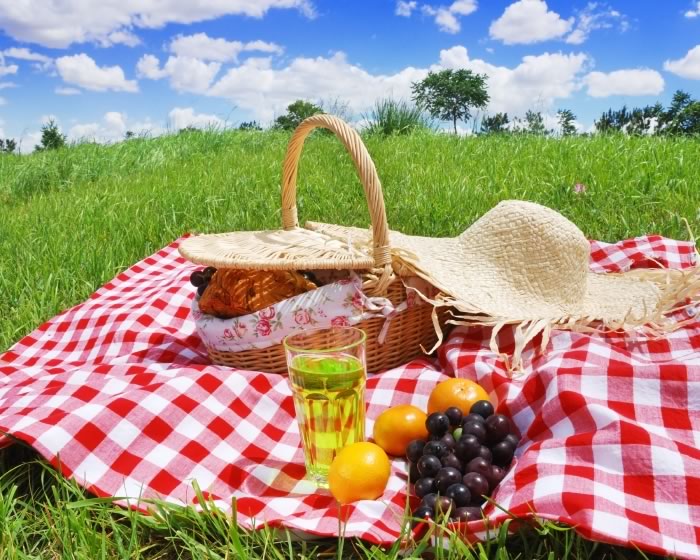One of the biggest joys of summer is eating outside in the fresh air, with nothing but sky and trees overhead. Whether at an alfresco cafe or in your own back yard, it instantly helps you decompress. Take it a step further by grabbing a blanket and heading to the park or beach for a picnic, and a meal can feel like a mini-vacation. But pulling a couple of limp turkey sandwiches out of your backpack after they’ve spent hours in the heat is not going to cut it. Besides being unappetizing, they could make you sick. Instead, take a moment to plan your picnic right so it is both delicious and healthful.

Sweet-Tart Slaw with Fig Dressing
To chill . . .
To keep perishables like those turkey sandwiches fresh-tasting and safe to eat, they need to be stored at 40 degrees or below (essentially, refrigerator temperature) and then not left out at mealtime for more than two hours (if it is over 90 degrees outside, make that one hour). That’s because harmful bacteria grow rapidly at temperatures between 40 and 140 degrees and really thrive in the 90-to-110-degree range.
So even if you have your heart set on finally using that antique wicker basket that has been collecting dust on your shelf, it’s important to pack all prepared foods — including poultry, meat, seafood, bean dishes, dips, salads (with or without mayo), cold cuts, soft cheeses and cut produce — in an insulated cooler, and make sure it stays cold. The best way to know whether your cooler is at the right temperature is to use a refrigerator thermometer, which you can pick up inexpensively at the grocery or hardware store. But as a rule, if there is still ice in it, you are in the right zone. If the ice is melted or the temperature is starting to inch above 40 degrees before you plan to eat, it’s time to go on an ice run.
You might balk at this “colder than 40 degrees/less than two-hour window” rule — I have found many people do. I know, I know, you have kept your chicken and potato salad out of the cooler for several hours at a time, for as long as you can remember, without incident, so you just don’t believe all this chilling is necessary. The thing is, eating food that has been sitting around in the heat isn’t guaranteed to make you sick — it just dramatically increases the likelihood of it. So keeping food out too long is a kind of culinary Russian roulette. And some food-borne bacteria take days or a week to affect a person, so you might have made people ill over the years and never known. Why continue to risk it?
. . . Or not to chill
There are several picnic-friendly foods that don’t need to be chilled, though, so you can make good use of that charming wicker carrier after all. Most produce is fine unrefrigerated before it is cut or peeled, and it adds seasonal flair, color and nutrition to the spread; so bring a bounty of it. Cherries, grapes, peaches, plums, figs, berries, whole melons, tomatoes, cucumbers, radishes, snap peas, avocado — are all summer favorites that you can bring along whole and easily cut or peel on site if needed. Do, however, wash and dry them well before you pack them up. (It’s a good idea to wash fruit with rinds or skin you don’t eat so you don’t drag bacteria into the flesh as you slice it).
Other healthful nonperishables to bring along are whole-grain crackers, nuts and nut butters, and dried fruit. Hunks of cheese aged two years or longer, including Parmesan, Romano, aged Gouda and cheddar may also be left out, as well as many dried and cured meats, sausages and jerky. But to keep your picnic healthfully balanced, don’t rely too heavily on cheeses and processed meats because they are quite high in salt and saturated fat. Also keep in mind that many modern dried and cured products are made with a short-cut method and do require refrigeration. Be sure to check the package to make sure there are no refrigeration instructions specified.
Pack and travel smart

Happily, there are all kinds of cute (even wicker-covered!) coolers and insulated backpacks available, so you can keep your food chilled in style. Whichever cooler you choose, pack it with plenty of ice and/or ice packs, and, since heat rises, be sure to place some of the ice on top of the food. Consider freezing a couple of water bottles — they stay frozen for a long time and are refreshing to drink once they melt. You might also want to pack a separate cooler for beverages, so you are not constantly in and out of the main cooler and it can hold its temperature better.
To optimize the chill factor, refrigerate food thoroughly at home before packing it up so it goes into the cooler cold; and pack it to the brim because coolers stay colder longer when they’re full. When traveling to your destination, put the chilled food in the passenger compartment of the car, instead of in the hot trunk, and keep it in the shade once you get to your spot.
A couple more items to pack: a good knife covered with a sheath and a clean cutting board to slice produce right before eating; and some soap and a jug of water or hand sanitizer so you can wash up between your game of Frisbee and handling the food. Lastly, don’t forget to take a couple of trash bags along so that when you are done enjoying your happy, healthful picnic, you leave the spot as tidy as you would like to find it when you return.



